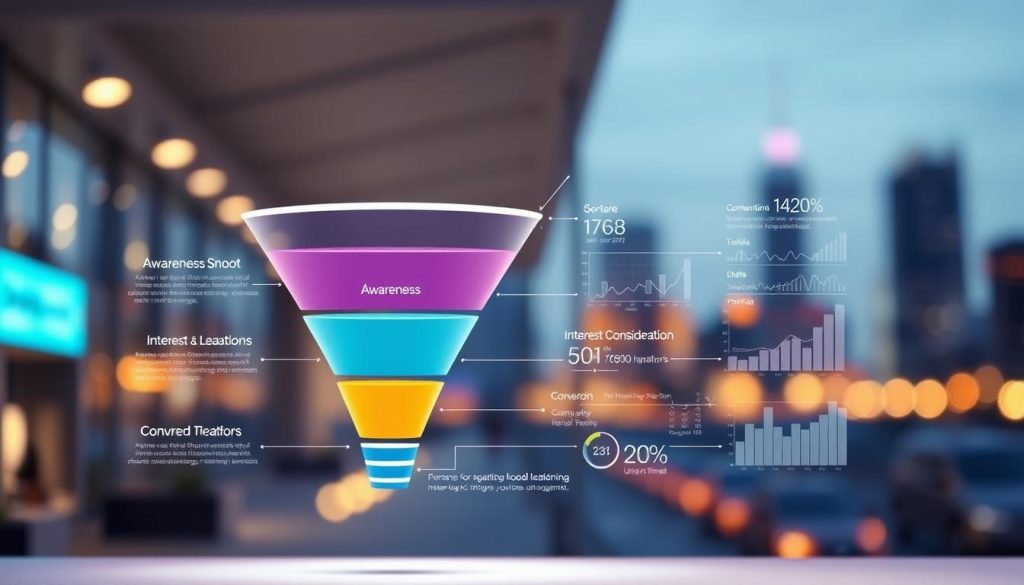We recognize that a streamlined approach to qualifying leads and engaging customers is essential for driving business growth. By defining high-quality leads, leveraging personal branding, and adapting to consumer behavior, businesses can create a customer-centric strategy that fosters long-term success.
Effective lead qualification and marketing strategies are crucial for sustainable growth. Companies like HubSpot and Hootsuite have successfully implemented lead scoring and customer profiling to target their ideal audience.
Key Takeaways
- Define high-quality leads to create a customer-centric strategy.
- Leverage personal branding to build trust with your target audience.
- Adapt to consumer behavior to stay ahead of the competition.
- Use lead scoring and customer profiling to target your ideal audience.
- Implement effective lead qualification and marketing strategies for sustainable growth.
Understanding Qualified Leads in Marketing
To develop effective marketing strategies, it’s essential to grasp what qualified leads are. Qualified leads are potential customers who have shown interest in a product or service and have the potential to become actual customers. Understanding qualified leads helps businesses focus their efforts on the most promising prospects.

Definition of Qualified Leads
A qualified lead is a prospect that has been vetted through a lead qualification process, which assesses their likelihood of becoming a customer. This process involves evaluating factors such as the lead’s budget, decision-making authority, need for the product or service, and timeline for making a purchase. By defining what constitutes a qualified lead, businesses can ensure their marketing efforts are targeted and efficient.
For instance, companies like HubSpot use specific criteria and lead scoring systems to qualify leads. Lead scoring assigns numerical values to leads based on their behavior and characteristics, helping sales teams prioritize their efforts on the most promising leads.
Importance of Qualified Leads
Qualified leads are crucial for generating leads that convert into sales. By focusing on qualified leads, businesses can optimize their marketing resources, improve conversion rates, and ultimately drive revenue growth. Qualified leads also enable sales teams to personalize their approach, building stronger relationships with potential customers.
Moreover, understanding and identifying qualified leads helps in reducing the sales cycle. When the sales team is dealing with qualified leads, they are more likely to close deals faster because these leads are already predisposed towards making a purchase.
Types of Qualified Leads
There are generally two types of qualified leads: Marketing Qualified Leads (MQLs) and Sales Qualified Leads (SQLs). MQLs are leads that have shown interest in a product or service through their interactions with marketing campaigns, such as downloading an e-book or attending a webinar. SQLs, on the other hand, are leads that have been deemed ready for a direct sales follow-up, having met specific criteria that indicate they are likely to make a purchase.
For effective lead generation, it’s crucial to understand the distinction between these types and tailor marketing strategies accordingly. For more insights on content marketing strategies that can help in generating qualified leads, visit Christoph Olivier Consulting.
The Role of Target Audience Analysis
Target audience analysis plays a pivotal role in tailoring marketing efforts for sustainable growth. By understanding the needs, preferences, and pain points of our target audience, we can develop targeted marketing strategies that resonate with potential customers.
Creating Buyer Personas
Creating detailed buyer personas is a crucial step in understanding our target audience. These personas are semi-fictional representations of our ideal customers, based on data and research. They help us understand the motivations, challenges, and behaviors of our potential customers.
To create effective buyer personas, we need to gather insights from various sources, including customer surveys, social media, and sales data. This information allows us to tailor our marketing efforts to address the specific needs and concerns of our target audience.
Segmenting Your Audience
Segmenting our audience involves dividing our broader target audience into smaller, more specific groups based on shared characteristics. This could include demographic factors, buying behavior, or firmographic data for B2B businesses.
By segmenting our audience, we can develop more targeted and effective marketing campaigns that speak directly to the needs and interests of each segment, thereby improving our B2B lead generation efforts.
Analyzing Customer Behavior
Analyzing customer behavior is essential for understanding how our target audience interacts with our brand and where there are opportunities to improve our marketing efforts. This involves tracking metrics such as website interactions, email engagement, and social media activity.
By analyzing these behaviors, we can identify patterns and trends that inform our marketing strategies, allowing us to make data-driven decisions that drive growth and improve customer engagement.

| Aspect | Description | Benefits |
|---|---|---|
| Buyer Personas | Semi-fictional representations of ideal customers based on data and research. | Helps tailor marketing efforts to specific needs and concerns. |
| Audience Segmentation | Dividing the target audience into smaller groups based on shared characteristics. | Allows for more targeted and effective marketing campaigns. |
| Customer Behavior Analysis | Tracking and analyzing how the target audience interacts with the brand. | Informs marketing strategies and improves customer engagement. |
Effective Lead Generation Strategies
Generating high-quality leads is essential for sustainable business growth. We implement various strategies to attract potential customers and drive conversions. Effective lead generation is crucial for filling the sales funnel with qualified prospects.
Content Marketing Techniques
Content marketing is a powerful tool for generating leads. We create valuable, relevant, and consistent content to attract and retain a clearly defined audience.
Our content marketing techniques include:
- Blog posts that address customer pain points
- E-books and whitepapers that provide in-depth information
- Case studies that showcase success stories
Social Media Engagement
Social media platforms are vital for lead generation. We leverage these channels to engage with our audience, build brand awareness, and drive traffic to our website.
Our social media strategy includes:
- Creating engaging content that resonates with our audience
- Utilizing paid social media advertising to reach a wider audience
- Monitoring and responding to comments and messages promptly
Webinars and Online Events
Webinars and online events are effective for generating leads and establishing thought leadership. We host webinars on topics relevant to our audience, providing valuable insights and information.
The benefits of webinars include:
- Establishing authority in our industry
- Generating high-quality leads
- Providing value to our audience
Paid Advertising
Paid advertising is a crucial component of our lead generation strategy. We use targeted ads to reach potential customers who are likely to be interested in our products or services.
Our paid advertising strategy includes:
- Google Ads for targeted search advertising
- Social media ads for reaching a wider audience
- Retargeting ads to reach users who have visited our website
| Strategy | Cost | Lead Quality |
|---|---|---|
| Content Marketing | Low | High |
| Paid Advertising | High | Medium |
| Webinars | Medium | High |
| Social Media | Low | Medium |

Nurturing Leads Through the Sales Funnel
The journey from lead to customer is paved with strategic nurturing, a process that is crucial for sustainable growth. As leads navigate through the sales funnel, it’s essential to provide them with relevant content and engagement to build trust and foster a meaningful connection.

Building Relationships with Prospects
Building strong relationships with prospects is at the heart of effective lead nurturing. Personalization is key; it involves tailoring your communication to address the specific needs and interests of each lead. By doing so, we can create a more engaging experience that resonates with potential customers.
According to a study, personalized emails have a higher open rate and click-through rate compared to generic emails. This highlights the importance of understanding our audience and crafting messages that speak directly to them.
Email Marketing Strategies
Email marketing remains one of the most effective channels for nurturing leads. Crafting compelling content that educates and informs is crucial. We should focus on providing value to our leads, whether through industry insights, helpful tips, or exclusive offers.
- Segment your email list to ensure targeted communication.
- Use compelling subject lines to increase open rates.
- Include clear calls-to-action to guide leads further down the funnel.
“Email marketing is not just about sending emails; it’s about creating a conversation with your leads.”
Automated Lead Nurturing
Automated lead nurturing allows us to streamline the process of engaging with leads without sacrificing personalization. By leveraging marketing automation tools, we can deliver timely and relevant content to leads based on their behavior and preferences.
For instance, when a lead downloads an e-book, we can trigger an automated email sequence that provides additional resources on the same topic. This not only nurtures the lead but also positions our brand as a thought leader in the industry.
Aligning Sales and Marketing Teams
To achieve sustainable growth in qualified leads marketing, aligning sales and marketing efforts is crucial. This alignment ensures that both teams work towards common goals, maximizing the impact of their efforts.

Importance of Collaboration
Collaboration between sales and marketing teams is essential for effective B2B lead generation. When both teams are aligned, they can better understand each other’s challenges and work together to create targeted strategies that drive results.
Treating sales teams as internal customers is a strategy that fosters better collaboration. By understanding the needs and pain points of the sales team, marketing can tailor their efforts to deliver high-quality leads that meet sales requirements.
“When sales and marketing teams are aligned, they can work together to create a seamless customer experience, from initial lead generation to closing deals.”
Tools for Better Communication
Utilizing the right tools is vital for enhancing communication between sales and marketing teams. CRM systems and marketing automation platforms are crucial for ensuring that both teams have access to the same data and insights, facilitating a unified approach.
- Regular meetings and joint planning sessions
- Shared dashboards and reporting tools
- Collaboration software for real-time communication
Shared Goals and Metrics
Establishing shared goals and metrics is fundamental to aligning sales and marketing teams. By defining common KPIs, both teams can work towards the same objectives, ensuring a cohesive strategy that drives qualified leads marketing success.
Some key metrics to consider include lead conversion rates, sales cycle length, and customer acquisition costs. By tracking these metrics together, sales and marketing teams can identify areas for improvement and optimize their strategies accordingly.
Utilizing Marketing Automation Tools
By leveraging marketing automation, companies can streamline their efforts and achieve sustainable growth. Marketing automation tools enable businesses to nurture leads more effectively and personalize their marketing efforts, leading to improved conversion rates and enhanced customer engagement.
Benefits of Automation
The benefits of marketing automation are multifaceted. Automation allows for the personalization of marketing messages, making them more relevant to the target audience. It also enables businesses to nurture leads through the sales funnel more efficiently, reducing the likelihood of leads going cold.
According to a recent study, businesses that use marketing automation see a significant improvement in their lead generation efforts. “Marketing automation is no longer a nice-to-have; it’s a must-have for businesses looking to stay competitive,” says a marketing expert.
Popular Marketing Automation Platforms
Several marketing automation platforms have gained popularity among businesses. Some of the most widely used include:
- HubSpot
- Marketo
- Pardot
- Mailchimp
These platforms offer a range of features, from email marketing automation to lead scoring and CRM integration.
Integration with CRM Systems
One of the key advantages of marketing automation tools is their ability to integrate with CRM systems. This integration enables businesses to align their sales and marketing efforts more closely, ensuring that leads are properly nurtured and converted into customers.

As noted by a marketing automation expert, “The integration of marketing automation with CRM systems is crucial for businesses looking to maximize their ROI.” This integration allows for a seamless flow of data between the two systems, enhancing the overall efficiency of the sales and marketing processes.
Leveraging Data and Analytics
By leveraging data and analytics, companies can significantly enhance their targeted marketing efforts and improve overall campaign performance. This strategic approach enables businesses to make informed decisions, optimize their marketing strategies, and ultimately drive sustainable growth.
Tracking Lead Sources
Understanding where your leads come from is crucial for allocating resources effectively. By tracking lead sources, we can identify which channels are most effective for generating leads.
Some common lead sources include:
- Social media platforms
- Email marketing campaigns
- Search engine optimization (SEO)
- Paid advertising
Analyzing these sources helps us refine our marketing strategies to maximize ROI.
Analyzing Campaign Performance
Campaign performance analysis is vital for understanding the effectiveness of our marketing efforts. We examine metrics such as conversion rates, click-through rates, and engagement levels to gauge campaign success.
| Campaign | Conversion Rate | Click-Through Rate |
|---|---|---|
| Campaign A | 2.5% | 0.8% |
| Campaign B | 3.2% | 1.2% |
| Campaign C | 1.8% | 0.6% |
This data allows us to adjust our strategies and improve future campaign performance.
Making Data-Driven Decisions
Data-driven decision-making is at the heart of effective marketing. By analyzing data, we can identify trends, opportunities, and challenges, enabling us to make informed decisions that drive results.
For instance, data can reveal:
- Customer behavior patterns
- Preferences and interests
- Market trends
By leveraging these insights, we can tailor our marketing efforts to better meet the needs of our target audience.
Optimizing Landing Pages for Conversions
Converting visitors into customers starts with optimizing your landing pages. We will explore the strategies that make landing pages effective, including key elements, A/B testing, and best practices for call-to-actions.
Key Elements of Effective Landing Pages
Effective landing pages are designed with specific elements that enhance their ability to convert visitors. These include:
- Clear and Concise Headlines: Capturing the visitor’s attention immediately.
- Relevant and Engaging Content: Providing value to the visitor and aligning with their expectations.
- Prominent Call-to-Actions (CTAs): Guiding the visitor towards the desired action.
- Minimal Distractions: Ensuring the focus remains on the primary goal of the page.
By incorporating these elements, we can significantly improve the performance of our landing pages, thereby enhancing our sales funnel optimization efforts.
A/B Testing for Improvements
A/B testing is a crucial technique for optimizing landing pages. It involves comparing two versions of a page to determine which one performs better.
| Element to Test | Purpose | Potential Impact |
|---|---|---|
| Headline Variations | Identify more engaging headlines | Higher click-through rates |
| CTA Button Color | Determine the most effective color | Increased conversions |
| Content Layout | Optimize the layout for better flow | Improved user engagement |
Through A/B testing, we can make data-driven decisions to continually improve our landing pages, enhancing our lead nurturing techniques.
Call-to-Action Best Practices
The call-to-action is a critical component of any landing page. Best practices for CTAs include:
- Visibility: Ensuring the CTA is prominently displayed.
- Clarity: Using clear and direct language on the CTA.
- Urgency: Creating a sense of urgency to prompt action.
By implementing these best practices, we can improve the effectiveness of our CTAs, driving more conversions and enhancing our overall sales funnel optimization strategy.
Measuring ROI for Qualified Leads
To truly understand the effectiveness of our qualified leads marketing efforts, we must accurately measure the return on investment (ROI). This involves a comprehensive analysis of various metrics that help us evaluate the performance of our lead generation strategies.
Understanding Key Performance Indicators (KPIs)
KPIs are quantifiable measures that indicate the success of our marketing efforts. For qualified leads, key KPIs include conversion rates, lead-to-customer ratio, and customer acquisition cost. By tracking these KPIs, we can gain insights into the effectiveness of our lead qualification process and make data-driven decisions to optimize our strategies.
Some essential KPIs to monitor include:
- Conversion rate: The percentage of leads that become customers.
- Lead-to-customer ratio: The number of leads required to acquire one customer.
- Customer lifetime value (CLV): The total value a customer brings to the business over their lifetime.
Calculating Cost Per Lead
Understanding the cost per lead is crucial for evaluating the financial efficiency of our marketing campaigns. This involves calculating the total cost of generating leads, including expenses related to content creation, advertising, and personnel. By dividing the total cost by the number of leads generated, we can determine the cost per lead.
For example, if our total marketing spend for a campaign is $10,000 and we generate 1,000 leads, the cost per lead would be $10. This metric helps us assess the ROI of different marketing channels and campaigns.
Long-term Value of Qualified Leads
Assessing the long-term value of qualified leads is vital for understanding their true worth to our business. This involves analyzing the revenue generated by customers acquired through our lead generation efforts over time. By comparing this revenue to the cost of acquiring these customers, we can determine the ROI of our qualified leads marketing initiatives.
For instance, if the average customer acquired through our qualified leads marketing efforts generates $500 in revenue over their lifetime, and the cost to acquire this customer was $100, the ROI would be significant. This analysis helps us refine our marketing strategies to focus on high-value leads and improve overall campaign performance.
The Impact of Content on Lead Quality
High-quality content is the backbone of any successful inbound marketing strategy, directly influencing lead quality. We understand that the type of content created and disseminated plays a crucial role in attracting and nurturing leads.
Creating Valuable Content
Creating valuable content is essential for capturing the attention of potential leads. Valuable content is that which addresses the needs, concerns, and interests of the target audience. We achieve this by conducting thorough research into our audience’s preferences and pain points, allowing us to tailor our content accordingly.
Some key strategies for creating valuable content include:
- Understanding the buyer’s journey and creating content that caters to each stage
- Focusing on providing solutions rather than just promoting products
- Utilizing various content formats such as blog posts, videos, and eBooks to cater to different preferences
Educational vs. Promotional Content
Striking a balance between educational and promotional content is vital. While promotional content is necessary for showcasing products and services, educational content helps in building trust and establishing authority in the industry.
Educational content can take many forms, including:
- Informative blog posts that address common questions or issues
- Detailed guides and whitepapers that provide in-depth information on complex topics
- Webinars and online courses that educate the audience on relevant subjects
Leveraging Case Studies and Testimonials
Case studies and testimonials are powerful tools for demonstrating credibility and showcasing success stories. They provide social proof that can significantly influence a lead’s decision-making process.
To effectively leverage case studies and testimonials, we:
- Highlight specific challenges and how they were overcome
- Use data and metrics to quantify the success achieved
- Feature them prominently on our website and in marketing materials
Trends in Qualified Leads Marketing
To stay ahead in the competitive arena of qualified leads marketing, understanding the current trends is not just beneficial, it’s essential. The landscape of lead generation is constantly evolving, driven by technological advancements and changing consumer behaviors.
As we explore the trends shaping the industry, it’s clear that businesses must adapt to remain competitive. Let’s examine some of the key trends influencing qualified leads marketing today.
Rise of Artificial Intelligence
Artificial Intelligence (AI) is revolutionizing the way businesses approach lead generation strategies. AI-powered tools can analyze vast amounts of data to identify potential leads, predict their behavior, and personalize marketing efforts. For instance, AI-driven chatbots can engage with website visitors, gather information, and qualify leads in real-time. According to recent lead generation statistics, businesses that adopt AI technologies see a significant improvement in their lead conversion rates.
Moreover, AI can help in optimizing marketing campaigns by analyzing performance data and suggesting improvements. This not only enhances the efficiency of lead generation efforts but also ensures that marketing budgets are utilized effectively.
Personalization in Marketing
Personalization has become a cornerstone of effective marketing strategies, particularly in generating leads. Consumers today expect tailored experiences that cater to their specific needs and preferences. By leveraging data analytics and marketing automation tools, businesses can create highly personalized campaigns that resonate with their target audience.
For example, personalized email marketing campaigns can significantly boost engagement rates. By addressing leads by their names and tailoring the content based on their interests, businesses can build stronger connections with potential customers. As noted by experts at Christoph Olivier Consulting, personalization is key to standing out in a crowded market.
The Future of Lead Generation
Looking ahead, the future of lead generation is likely to be shaped by continued advancements in technology and evolving consumer expectations. Trends such as the increased use of voice search, augmented reality (AR), and virtual reality (VR) are expected to play a significant role in how businesses attract and engage potential leads.
Furthermore, the importance of data privacy and security will continue to grow. Businesses will need to balance the need for personalized marketing with the requirement to protect consumer data. By staying informed about these trends and adapting their strategies accordingly, businesses can position themselves for success in the ever-changing landscape of qualified leads marketing.
Best Practices for Sustainable Lead Marketing
To achieve long-term success in lead marketing, businesses must adopt strategies that drive continuous growth and improvement. This involves implementing targeted marketing techniques that resonate with the target audience and optimizing the sales funnel to maximize conversions.
Continuous Improvement Strategies
We continually assess and refine our lead generation strategies to stay ahead of the competition. This includes leveraging data and analytics to inform decision-making and drive campaign optimization.
Staying Adaptable to Changes
Staying adaptable is crucial in today’s fast-paced marketing landscape. We achieve this by embracing new technologies and trends, such as marketing automation and AI-powered tools, to enhance our sales funnel optimization efforts.
Building Brand Reputation and Trust
Building a strong brand reputation and trust with our audience is critical for sustainable lead marketing. We achieve this by creating high-quality, relevant content that addresses the needs and concerns of our target audience, ultimately driving long-term growth and customer loyalty through effective targeted marketing.
